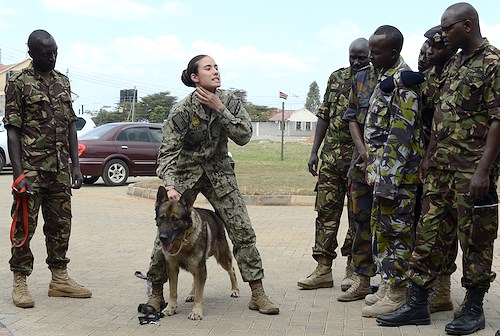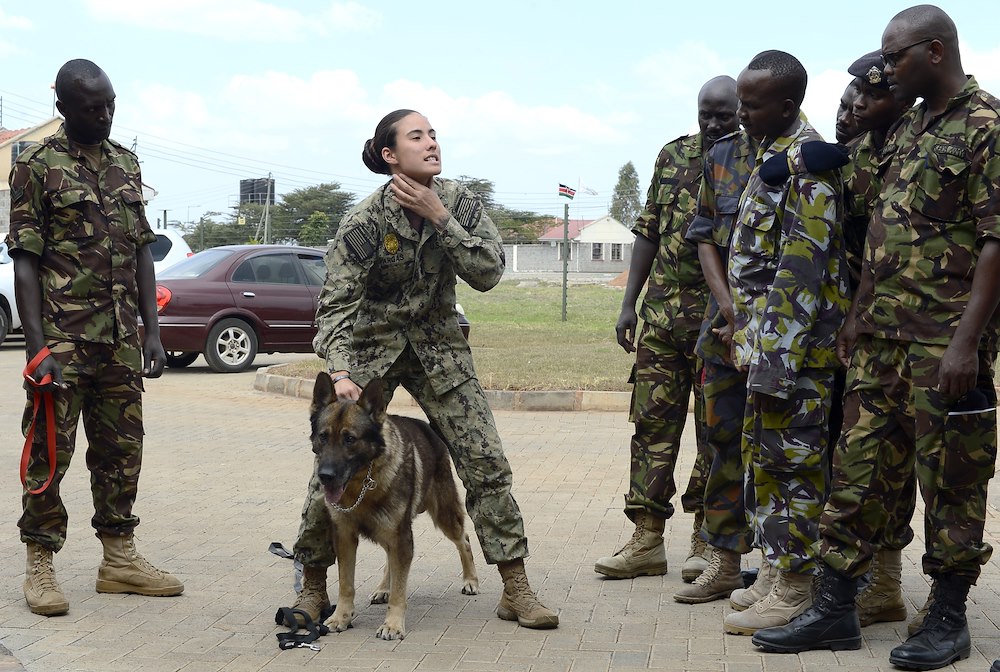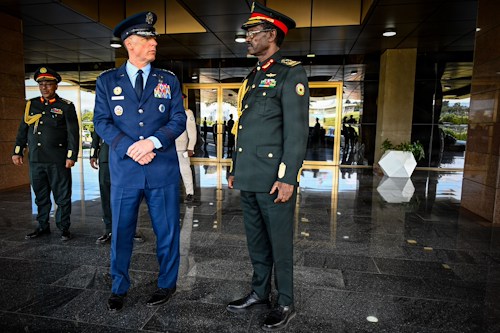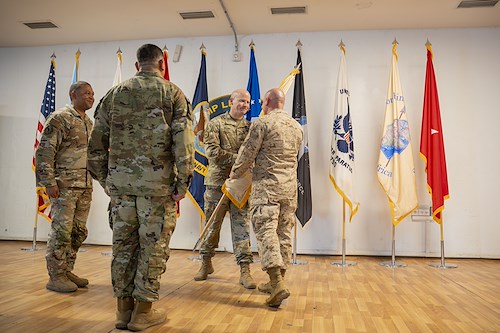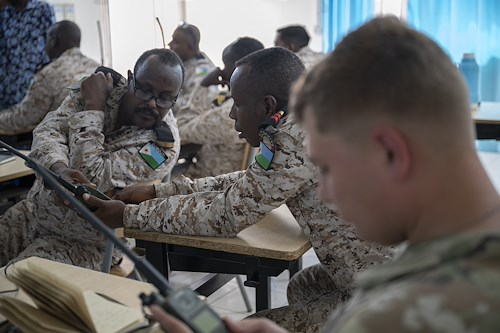Gallery contains 10 images
×
Photo 1 of 10
CJTF-HOA trades Canine experience, knowledge with Kenya Defense Force
Master at Arms 1st Class Kristina Vargas, the Kennel Master assigned to Camp Lemonnier, explains the importance of properly applying a collar on a military working dog for members of the Kenyan Defense Force's 1st Canine Regiment during a knowledge exchange, in Nairobi, Kenya, August 8, 2018. The exchange gave a chance for American and Kenyan forces to learn and work with each other to have a better understanding of each other's capabilities. (U.S. Navy Photo by Mass Communication Specialist 2nd Class Timothy M. Ahearn)
Photo by: Mass Communication Specialist 2nd Class Timothy M. Ahearn
Photo 2 of 10
CJTF-HOA trades Canine experience, knowledge with Kenya Defense Force
Kenyan Maj. Marion Amulyoto, Lead Veterinarian, 1st Canine Regiment, Kenya Defense Force, and Army Maj. Steven Pelham, 404th Civil Affairs Battalion Functional Specialty Team, Veterinarian Officer in Charge, test a stethiscope during a military working dog knowledge exchange, in Nairobi, Kenya, August 7, 2018. The exchange gave a chance for American and Kenyan forces to learn and work with each other to have a better understanding of each other's capabilities. (U.S. Navy Photo by Mass Communication Specialist 2nd Class Timothy M. Ahearn)
Photo by: Mass Communication Specialist 2nd Class Timothy M. Ahearn
Photo 3 of 10
CJTF-HOA trades Canine experience, knowledge with Kenya Defense Force
Kenya Defense Force (KDF) Maj. Marion Amulyoto, a veterinarian with KDF’s 1st Canine Regiment, discusses the hazards of heat exhaustion for military working dogs for members of the Kenyan Defense Force's 1st Canine Regiment during a knowledge exchange, in Nairobi, Kenya, August 7, 2018. The exchange gave a chance for American and Kenyan forces to learn and work with each other to have a better understanding of each other's capabilities. (U.S. Navy Photo by Mass Communication Specialist 2nd Class Timothy M. Ahearn)
Photo by: Mass Communication Specialist 2nd Class Timothy M. Ahearn
Photo 4 of 10
CJTF-HOA trades Canine experience, knowledge with Kenya Defense Force
Army Capt. James McKasson, a veterinarian with the 404th Civil Affairs Battalion’s Functional Specialty Team, explains how to take proper canine vital signs for members of the Kenyan Defense Force's 1st Canine Regiment during a Military Working Dog knowledge exchange, in Nairobi, Kenya, August 7, 2018. The exchange gave a chance for American and Kenyan forces to learn and work with each other to have a better understanding of each other's capabilities. (U.S. Navy Photo by Mass Communication Specialist 2nd Class Timothy M. Ahearn)
Photo by: Mass Communication Specialist 2nd Class Timothy M. Ahearn
Photo 5 of 10
CJTF-HOA trades Canine experience, knowledge with Kenya Defense Force
Master at Arms 1st Class Kristina Vargas, the Kennel Master assigned to Camp Lemonnier and Kenya Army Cpl. Junior Kimani, 1st Canine Regiment, Kenya Defense Force, conduct controlled aggression training during a Military Working Dog knowledge exchange, in Nairobi, Kenya, August 7, 2018. The exchange gave a chance for American and Kenyan forces to learn and work with each other to have a better understanding of each other's capabilities. (U.S. Navy Photo by Mass Communication Specialist 2nd Class Timothy M. Ahearn)
Photo by: Mass Communication Specialist 2nd Class Timothy M. Ahearn
Photo 6 of 10
CJTF-HOA trades Canine experience, knowledge with Kenya Defense Force
Master at Arms 1st Class Kristina Vargas, the Kennel Master assigned to Camp Lemonnier, conducts patrol work and demonstrates different techniques for members of the Kenyan Defense Force's 1st Canine Regiment during a Military Working Dog knowledge exchange, in Nairobi, Kenya, August 7, 2018. The exchange gave a chance for American and Kenyan forces to learn and work with each other to have a better understanding of each other's capabilities. (U.S. Navy Photo by Mass Communication Specialist 2nd Class Timothy M. Ahearn)
Photo by: Mass Communication Specialist 2nd Class Timothy M. Ahearn
Photo 7 of 10
CJTF-HOA trades Canine experience, knowledge with Kenya Defense Force
U.S. Army Spc. Lauren Reed, a veterinary technician with the 404th Civil Affairs Battalion Functional Specialty Team, demonstrates the proper restraint technique to administer a catheter to memebers of the Kenya Defense Force's 1st Canine Regiment during a Military Working Dog knowledge exchange in Nairobi, Kenya, August 7, 2018. The exchange gave a chance for American and Kenyan forces to learn and work with each other to have a better understanding of each other's capabilities. (U.S. Navy Photo by Mass Communication Specialist 2nd Class Timothy M. Ahearn)
Photo by: Mass Communication Specialist 2nd Class Timothy M. Ahearn
Photo 8 of 10
CJTF-HOA trades Canine experience, knowledge with Kenya Defense Force
Master at Arms 1st Class Kristina Vargas, the Kennel Master assigned to Camp Lemonnier, conducts patrol work and demonstrates different techniques for members of the Kenyan Defense Force's 1st Canine Regiment during a Military Working Dog knowledge exchange, in Nairobi, Kenya, August 7, 2018. The exchange gave a chance for American and Kenyan forces to learn and work with each other to have a better understanding of each other's capabilities. (U.S. Navy Photo by Mass Communication Specialist 2nd Class Timothy M. Ahearn)
Photo by: Mass Communication Specialist 2nd Class Timothy M. Ahearn
Photo 9 of 10
CJTF-HOA trades Canine experience, knowledge with Kenya Defense Force
Master at Arms 1st Class Kristina Vargas, the Kennel Master assigned to Camp Lemonnier, and Kenya Defense Force (KDF) Cpl. Robert Magori conduct patrol work and demonstrate different techniques for members of the KDF’s 1st Canine Regiment during a Military Working Dog knowledge exchange, in Nairobi, Kenya, August 7, 2018. The exchange gave a chance for American and Kenyan forces to learn and work with each other to have a better understanding of each other's capabilities.(U.S. Navy Photo by Mass Communication Specialist 2nd Class Timothy M. Ahearn)
Photo by: Mass Communication Specialist 2nd Class Timothy M. Ahearn
Photo 10 of 10
CJTF-HOA trades Canine experience, knowledge with Kenya Defense Force
Master at Arms 1st Class Kristina Vargas, the Kennel Master assigned to Camp Lemonnier, conducts patrol work and demonstrates different techniques for members of the Kenyan Defense Force's 1st Canine Regiment during a Military Working Dog knowledge exchange, in Nairobi, Kenya, August 7, 2018. The exchange gave a chance for American and Kenyan forces to learn and work with each other to have a better understanding of each other's capabilities. (U.S. Navy Photo by Mass Communication Specialist 2nd Class Timothy M. Ahearn)
Photo by: Mass Communication Specialist 2nd Class Timothy M. Ahearn
NAIROBI, Kenya—Kenyan and American service members teamed up to share the best ways to treat and train Military Working Dogs in the field, at the 1st Canine Regiment headquarters in Nairobi, August 6-10.
A U.S. Army Veterinary team assigned to the 404th Civil Affairs Battalion’s Functional Specialty Team (FXSP), assigned to Combined Joint Task Force- Horn of Africa (CJTF-HOA) and a U.S. Navy MWD Kennel Master, deployed to Camp Lemonnier (CLDJ), shared their knowledge on the treatment and training of the working dogs.
Founded in 2012, the Kenya Defense Force’s 1st Canine Regiment’s mission is to provide dogs as a force multiplier in war and peacetime in order to overcome the current threat of asymmetric warfare. To that end, they specialize in explosive detection, patrolling, road and building clearance, and search and rescue, said Major Marion Amulyoto, a veterinarian with the 1st Canine Regiment.
“We have been a valuable resource to our commanders, especially along the borders,” said Amulyoto, “Our explosive detection dogs deter violent extremists, because they are able to pick up on residual odors from explosives.”
This mission often brings dogs and their handlers to the Kenya-Somalia border to deter transnational threats, such as poachers, and violent extremist organizations, said U.S. Army Major Steven Pelham, the veterinarian officer in charge with the 404th Civil Affairs Battalion FXSP.
The FXSP veterinarians’ portion of the exchange included information on bandaging, wound care, heat stroke, canine CPR, fractures, and suturing. They were appreciative of the 1st Canine Regiment veterinarians as they shared their knowledge of the dangers the dogs face, specifically in East Africa.
“Heat injuries and threats from wildlife our dogs do not normally encounter such as snakes, spiders, and scorpions are likely, given the environment that the U.S. and Kenyan MWDs operate in East Africa,” said Pelham, “We want to ensure that all MWD handlers recognize and treat their partners in case they suffer from these injuries.”
This exchange also marked the first time that members of the 1st Canine Regiment could share knowledge with a U.S. Navy handler.
“I am really excited to work with the 1st Canine Regiment’s MWD handlers; to share working knowledge with our Kenyan partners is an amazing opportunity,” said Master at Arms 1st Class Kristina Vargas, CLDJ’s Kennel Master.
While learning the various techniques that the 1st Canine Regiment uses in their daily operations, Vargas shared knowledge of basic explosive detection, patrolling, building clearing, and improvised explosive device (IED) recognition.
For Vargas, being able to work with fellow handlers is very familiar, regardless of which nation the handler is from.
“When you get MWD handlers together, regardless of their branch of service or even if they are from another country, at the end of the day we are all dog handlers helping out dog handlers, we share the same passion for our respective MWD programs,” said Vargas.
Kenya is the only country in East Africa with a canine unit organic to its military. Learning from one another assists both the 1st Canine Regiment and CJTF-HOA in maintaining security and stability in the area of operations.
“We are very grateful to CJTF-HOA for this exchange program and we hope to have more in the future to better both of our capabilities,” said Amulyoto.
The FXSP Veterinary team and Vargas departed knowing that they have strengthened the relationship with a key East African partner. The KDF can take use the knowledge they to increase their security, counter threats from violent extremists, and promote regional security.

